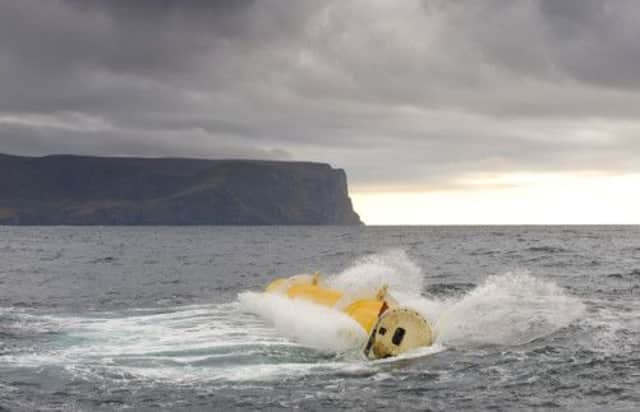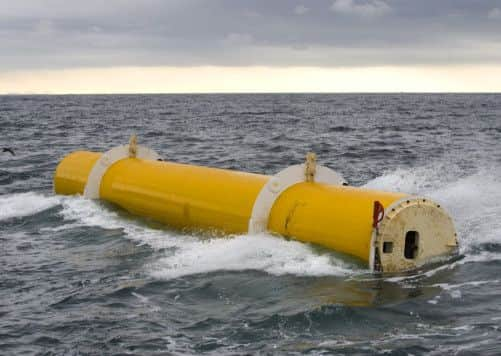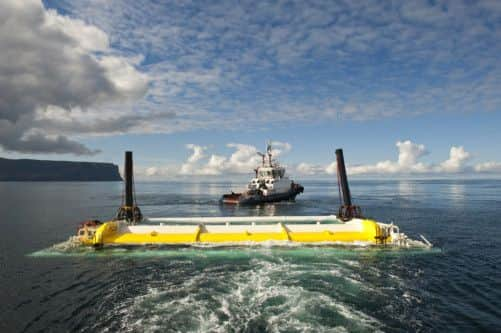World’s largest wave power scheme given go-ahead


Edinburgh-based Aquamarine Power has received full consent from ministers to develop a 40-megawatt wave farm off the north-west coast of Lewis – the world’s largest ocean energy site.
The announcement was made by Fergus Ewing, the Scottish minister for energy, enterprise and tourism, on the opening day of an “All-Energy” conference and exhibition in Aberdeen – the major showcase of the renewables industry.
Martin McAdam, the chief
Advertisement
Hide AdAdvertisement
Hide Ad

executive of Aquamarine Power, said: “This is a significant milestone for our company.
“The goal of our industry is to become commercial, and to do this we need two things: reliable technologies and a route to
market. Our engineers are currently working hard on getting the technology right and we now have a site where we can install our first small farm, with a larger-scale commercial build out in the years ahead.
“We have worked in close consultation with the people and businesses of Lewis in the development of our proposals and would like to express our gratitude for their ongoing


support.
“We were delighted with the turnout at the series of public exhibitions we held on Lewis last March, and we also commend government regulator Marine Scotland and the Western Isles Council for their positive approach.”
Milestone
Mr Ewing hailed the go-ahead as “another significant milestone” in Scotland’s renewables drive.
He said: “I am delighted to announce that Scottish ministers have granted a licence to Aquamarine Power to develop the largest commercial wave array in the world. Aquamarine Power is an exciting, dynamic Scottish company that is increasingly expanding its renewable business.
“This is another significant milestone for Scotland’s wave sector. With 10 per cent of Europe’s wave power potential, and 25 per cent of its offshore wind and tidal power potential, the opportunities for Scotland are enormous.”
Advertisement
Hide AdAdvertisement
Hide AdAquamarine, through its wholly owned subsidiary Lewis Wave Power, plans to begin installing its “Oyster” wave energy machines at the site within the next few years, once the necessary grid connections have been put in place.
The aim is to ultimately deploy between 40 and 50 of the wave power devices along the coast at Lag na Greine, near Fivepenny Borve, with a combined capacity to power nearly 30,000 homes.
However, energy giant SSE announced last week that it would not be able to commission work on a Western Isles subsea electricity cable, costing more than £700 million, before 2017.
Aquamarine Power is currently testing its second full-scale wave machine, known as the Oyster 800, at the European Marine Energy Centre in Orkney, and is now producing electrical power for the grid.
Niall Stuart, chief executive of Scottish Renewables, said the announcement was a “fantastic milestone” for the Scottish renewables industry which will make a significant contribution to the country’s energy mix.
Maria McCaffery, chief executive of RenewableUK, described the announcement as “a big step forward for the marine energy sector in the UK and especially in the Scottish islands”.
Councillor Angus Campbell, the leader of the Western Isles Council, pledged that the authority would be working with Aquamarine and other renewables companies to make the Western Isles the “location of choice” for future wave energy schemes.
Alasdair Allan, the SNP MSP for the Western Isles, stressed the need for work to begin on the subsea cable.
Advertisement
Hide AdAdvertisement
Hide AdHe said: “Today’s news represents further support for the islands’ renewables sector from the Scottish Government, and creates further pressure on SSE and the UK authorities to move forward with the interconnector to the mainland which the renewables sector needs.”
SEE ALSO: